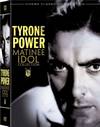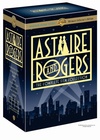


Errol Flynn & Olivia de Havilland
Filmography | Articles | Awards | Downloads | Bibliography | Links | Image Credits | Errol Flynn | Olivia de Havilland
| Article 5 |
Errol Flynn Restores Law and Order to 'Dodge City,' the Wild and Woolly Horse Opera at the Strandby Frank S. NugentNew York Times April 8, 1939, page 19Nothing much happens in "Dodge City," the Kansan pastoral presented at the Strand yesterday. Just a shooting scrape, a cattle stampede, a murder, a couple of street fights, another murder, a barroom brawl, a runaway, a few more street fights, another murder, a lynch mob's attach on a jail, a fight in a burning caboose and a few dull things like that. Errol Flynn skips through the debris as the frontier marshal out to restore law and order; and Olivia de Havilland is as pretty as ever -- prettier in fact, since she is in Technicolor -- as the miss who pretends to despise him for having shot her brother. It's curious, in a way, how unexciting most of it manages to be -- except to the youngsters who chortle and cheer. Possibly it's because one street fight looks much like another, because three men being tossed through windows are no more diverting than one would have been, because we have seen hard-headed extras tear the Gay Lady Saloon apart so many times before. Or possibly it is because suspense is an important element of drama and there can be no suspense when the hero is as invulnerable as Mr. Flynn's Wade Hatton appears to be. Jeff Surrett and his gang obviously were beaten from the start. With or without his six-gun, Marshal Hatton is a match for any three of Surrett's backroom gang. He stalks among them single-handed and comes away with the man they were going to lynch. He doesn't waste lead: with bullets flying all around, he wades in with his bare knuckles and a confident smile. Men are clubbed, slugged or plugged on all sides; the Marshal marches on. The wonder of it all is that Surrett's villains lasted so long. In their boots, we should have been headin' for the lone praireee [sic] while there still was time to decamp. Michael Curtiz's direction has been flawless part by part, but as a whole, it has failed to fuse his film into anything approaching dramatic unity. It has become merely an exciting thriller for the kiddies, or for grown folk with an appetite for the wild and woolly. The color is unusually good in several sequences and has a washed-out look in others. (At least no one can say now that Technicolor retards action.) The supporting case, including Alan Hale, Bruce Cabot, Frank McHugh, Victor Jory and Guinn Williams, seemed competent enough. Of course, it was hard to tell sometimes with all that gunsmoke and dust about. © 1939 New York Times |
Return to the Index of Articles. |
| Current Contest Prize: |
|---|
| Now in Print! |
|---|
| Now on DVD! |
|---|
Buy Videos & DVDs |
|
Buy Movie Posters |
|
Buy Movie Posters |
|
Classic
Movie Merchandise |
|
![]() Printer-friendly version.
Printer-friendly version.
![]() Return
to the top.
Return
to the top.
Last updated:
December 16, 2008.
Reel Classics is a registered trademark of Reel Classics, L.L.C.
© 1997-2009 Reel Classics, L.L.C. All rights reserved. No
copyright is claimed on non-original or licensed material.
Terms of
Use.










